Profile of Ennistymon
Ennistymon is a country town of about 1,200 people lying in a drumlin valley on the southern edge of the Burren in North-Clare; two miles inland from the open Atlantic at Lahinch. The origins of this 19th century town go back to 1564 when the O'Briens of Thomond acquired a castle in a wooded estate by the cascading Cullenagh river. This castle was known as the 'Middle House', being central to the O'Brien castles at Dough (Lahinch) and Glann (Ennistymon). Local historians claim that the Ennistymon name - Inis Di Main (Island of the Middle House) is derived from this. Today, the Falls Hotel occupies the original castle site.
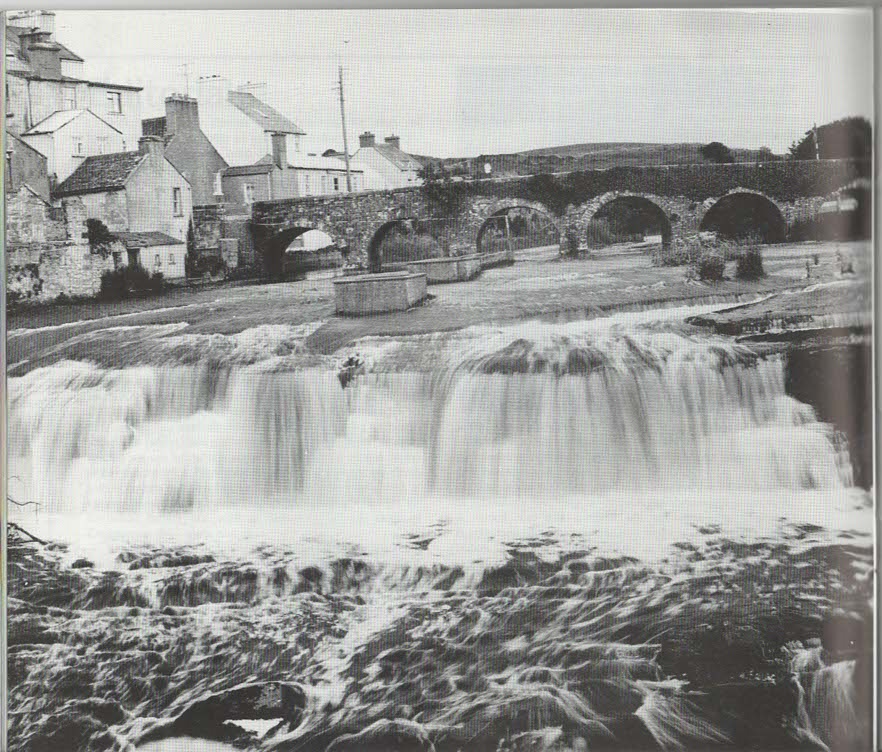
The Waterfalls of Ennistymon (Photo: Richard Owen)
The Market Town
The Tuesday market is nowadays but a shadow of that which took place there in the early part of this century, and very different to that in the early 1800's, when the country women sold home-made 'coarse' wool stockings at the river-crossing above the cascades. Then with the Napoleonic Wars generating a demand for cattle and horses, and the farmers of the area prospering; a rapid town development took place. From what were described as "3 miserable cabins" in the vicinity of the Mansion House of Edward O'Brien in 1770, there had been an increase of 120 houses by 1800.
Much later, there developed a market for fresh and salted butter. 'Ferkins' of butter lined the Main Street and the weighing and sampling was conducted there until the Market House in Church Street was built specially for that purpose. However, the Tuesday and Saturday pig and potato markets and the 6 annual cattle and horse fairs continued in the open street and fair green.
In 1887 the West-Clare railway was opened and shortly afterwards arrived in Ennistymon. Its initial commercial benefit was the immediate transportation of the butter and cattle from the markets and fairs, and the regular supply of goods to the shops. It also extended Ennistymon's hinterland as passengers from Miltown Malbay, Quilty and Corofin availed of the train; and Ennistymon became the largest market town in North Clare.
As an indication of the economy the town supported and the services it provided, Ennistymon had its own woollen mills for the manufacture of tweeds, friezes and flannels. Six families of tailors found a living in cutting this cloth into shape. There were eight establishments in the boot and shoe-making industry. And in the servicing of agricultural needs there were several blacksmiths, saddlers, coopers, basket-weavers and a coach-builder. Not surprisingly, the majority of families were engaged in the vintner and grocery trade. There was an unrivalled number of 48 pub/groceries in the town at the turn of the century. And today there are 20 licensed premises in Ennistymon.
This picture of Ennistymon as a thriving, self- sufficient market town continued up to the 1960's when, due to the agricultural changes brought about by the new creameries and cattle marts, the closing of the railway, and post-war emigration, the commercial prosperity of Ennistymon went into decline. The small family grocery came under threat from the chain-supermarket and some shops went out of business. Trades and tradesmen went out of fashion. However, the structural changes to the town were very few, as is evidenced by the presence of the many shop styles of that period. The Tuesday market still survives - albeit in a much smaller scale - as does the family grocery. And despite the attraction for a more mobile population to shop in Ennis and Limerick, or further afield, Ennistymon still serves a large hinterland to the north and west.
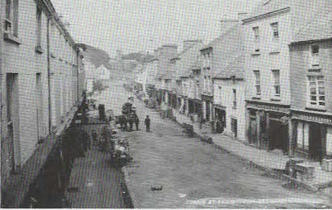 Ennistymon at the turn of the century. (Lawrence Collection)
Ennistymon at the turn of the century. (Lawrence Collection)
HISTORICAL AND POLITICAL
Ennistymon became the administrative centre in North Clare. Established in the nearby Workhouse (now the Ennistymon Hospital) was the Board of Guardians for the relief of the Union of Ennistymon. The area of administration of the Union was roughly the equivalent of the Ennistymon Rural Electoral Division of today which stretches from Ballyvaughan to Miltown Malbay. The population of the area has varied quite considerably over the years. The most recent Census of 1981 show a figure of 9,288 - a very slight actual increase from 1979, but a percentage decrease from the early '70s and the mid-60's.
The town was also the headquarters of the R.I.C. police force, and the Courts. Both authorities carried out their duties from adjoining buildings in Parliament Street. District Court sessions were held in the Courthouse until quite recently, but the former R.I.C. barracks is now the Social Welfare Office, and an attractive residence.
A company of the "Black and Tans" was housed in the Workhouse during the 1920's long after it had ceased to function for the relief of the destitute, and the duties of its Board of Guardians had been incorporated into the County Council. It was the presence of this company which provoked the Rineen Ambush on September 22, 1920, and the subsequent 'burning' of Ennistymon in reprisal on the following night. The incident has left no structural mark on the town - though six houses, including the Town Hall were burned - but the whole episode and the death of two innocent victims has left devastating recollections.
Another tragic incident took place when the R.I.C. was vacating the Barracks for the Republican troops. A hand-grenade exploded amongst the group of onlookers, mostly children, there to see the historical withdrawal. Several were injured, and some maimed for life.
Since the setting up of the State, Ennistymon has been the scene of large political rallies at election time; particularly, for de Valera who would arrive into town on the symbolic white horse. The area has strong Fianna Fail support. Of the five representatives from the Ennistymon Rural Electoral Division who fill seats in the County Council, three in the 1985 elections are Fianna Fail candidates, one Fine Gael and one Labour.
Strange to say there has been no
Dail representative from North-Clare since the Fine Gael T.D. 'Big' Bill Murphy
from Parliament Street, Ennistymon, held a seat from 1951 until his death in
1967.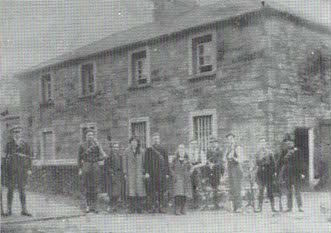
Men and women of Mid-Clare Brigade occupying the vacated R.I.C Barracks in 1922
ENNISTYMON TODAY
Commercially, Ennistymon is still dependent on the dairy-farming economy of the district, combined with some light industry in the town. The Creamery established at the North of the town in the 1930s, and where the prize-winning North Clare butter was once manufactured, is a daily collection point for the milk produce of the area, from where it is transported by lorry to Charleville for processing. The Tuesday market now invites traders in vegetables and potatoes, and 'hawkers' in clothes, shoes and hardware who erect temporary stalls in the Square. In early Spring there is also a more local pig and calf market. And in Autumn and Winter time there is a weekly livestock Mart. The farmers of North-Clare are well served by agricultural advisors based in the new ACOT building in Ennistymon. Here too young farmers can attend a '100 hour' course on modern farming methods.
Stubbens, a German owned factory, has been employing 45 Ennistymon people in the making of leather horse-riding equipment since the '50s. In 1979, Shannon Development Co. built an Enterprise Centre on the Western side of the town. Housed here is the electronic factory, Westec/Textlite employing 100.
These two industries then, together with the E.S.B. and Telecom Eireann and, of course, farming are the largest employers in the area. The majority of young school leavers migrate to Dublin to find work in the Public Service, or commute to work in Ennis or Shannon. Many also find temporary employment locally during the tourist season. Nevertheless, unemployment is a continuous problem in the region, particularly amongst the population of the town.
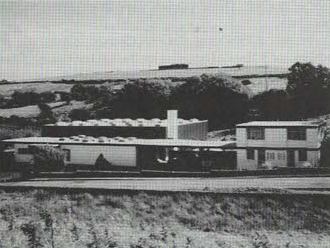
Stubbens Ireland Ltd. manufacturing up-market horse-riding equipment
EDUCATION
The two national schools in the town observe a traditional segregation of the sexes, in that the boys go to the Christian Brothers school (est. 1824) in Monastery Lane and the girls go to the Convent of Mercy School (est. 1876) on the hill. Ennistymon - being one of the largest praishes in North Clare has three 'outside' Churches and National Schools at Lahinch, Clooney and Furglan.
Both the Christian Brothers and the Sisters of Mercy provide a second level education to 180 boys and 255 girls respectively. The Vocational School provides Leaving Certificate and Secretarial courses to 150 boys and girls.
The catchment area for all three schools stretches beyond the Ennistymon parish to the neighbouring parishes of Carron, Kilfenora, Kilshanny, Liscannor, Lisdoonvarna, Inagh, Miltown Malbay and Quilty. The choice of school is determined by school bus route, school reputation, or subject emphasis, e.g. technical or academic. It is of interest to note here that one part-time teacher of art is shared between the Vocational School and the Convent of Mercy, and that the C.B.S. has not in the last few years provided the option of art to its pupils.
TOWN PLAN
The oldest part of the town is probably the street on the eastern side, near the Bridge. In the Griffith Evaluations of 1855 this street is referred to as "Old Town Street", because already the town was expanding northwards into "New Town Street" or present day Main Street. The Protestant Church, built in 1830, and prominent at the end of Church Street, terminates the northern flow of the town.
In more recent times development in the town has been in the area of residential housing. The Clare Co. Council housing schemes have been responsible for much of this; creating four peripheral concentrations of population in Ennistymon.
Churchill: This is probably the oldest residential area in the town. Originally the houses on this severe incline faced onto the road to the ruined church and cemetery. But in the 19th century the MacNamaras, as landlords in Ennistymon, built a row of 14 small family houses still known as Victoria Terrace on the slope of the hill, parallel to a similar development on the New Road at the foot of the hill. These houses were then rented to the populace.
In the 1950s the County Council completed a scheme of 3 'tiers' of housing on the left hand side of the Churchill Road. Some of the oldest families in the town still reside in Churchill, together with new arrivals and new names.
Circular Road: It is a continuation of Parliament Street which includes a terrace of 12 Council houses, and a selection of privately built bungalows. Circular Road is now one of the quieter, more settled parts of the town.
Ardnaculla: With over 40 houses, this is the largest County Council housing scheme in the town. In the '70s when the estate was completed many families from the smaller Churchill houses were accommodated across the river in Ardnaculla. This community - on the 'other side of the tracks' - houses many young families, as well as a number of old-age pensioners.
Kilcornan: The most recent County Council development on the eastern side of the town is this one. adjacent to Circular Road. A number of young families have also established themselves here over the past few years. The estate consists of 24 houses to date.
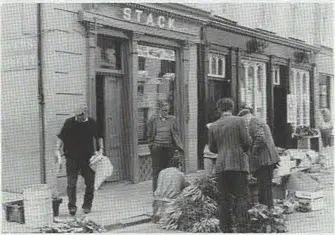
The Tuesday Market.
CULTURAL LIFE
The Ennistymon and North-Clare area has a very rich heritage in music, song, dance and folklore. Much of this has been passed down in the atmosphere of the country 'house dance-popular until the early part of this century-where the neighbours gathered to dance and play for "ceili sets"; and which was as natural and as indigenous a form of entertainment to have ever flourished.
Since the traditional music 'revival' of the '60s, Doolin village has acquired a phenomenal reputation for its music which attracts a mix of local and foreign people to listen and play. Impromptu sessions take place regularly now in many pubs in the area; and in Miltown Malbay there is an annual School for musicians dedicated to the local piper Willie Clancy. During the Summer months when there is an influx of visitors, music sessions are a big attraction; and these occasions have become part of the social entertainment of the area.
Contact with other art and entertainment forms are rare except through the medium of television. The nearest cinema is in Ennis, or in Lahinch during the Summer. And not since the '30s, when the Touring Theatre Companies visited Ennistymon regularly, have there been many opportunities to see professional drama.
The Library in Ennistymon is an important cultural facility in the area; and if membership numbers are any indication, then there is considerable interest in the literary arts. The large selection of fiction and reference works at Ennistymon, and comfortable surroundings in which to browse, attracts readers from Ballyvaughan to Miltown Malbay. Occasionally the library space is utilized for art exhibitions-mostly children's work-and historic- al displays of local interest.
Notwithstanding the improvement in living standards and modernisation in lifestyles which has taken place over the past 20 years, the cultural strongholds of the area are rooted in tradition. "Garland Sunday", associ- ated with Lahinch on the last Sunday of July, is a remnant of a pagan harvest festival and a significant date in the farming calendar. "Patrons" at "blessed wells" in Kilshanny, Moughna, Miltown Malbay and St. Brigid's Well in Liscannor take place annually, and traditional celebrations take place on the return of newly-weds when 'strawboys' usually entertain; and on St. John's night when a crowd gathers around a large bone-fire in Church Street.
The MacCurtains and other Ennistymon Poets:
Mention must also be made of the literary, and in some cases also legendary, characters who have contributed to the cultural heritage of the area; in particular, to the famous bardic poets and scholars of the MacCurtain family in the 17th century. The works of the most renowned of these, Aindrias and his cousin Aodh Bui, rank amongst the best of that era. The MacCurtains had a bardic school near Ennistymon. Aodh Bui enjoyed the patronage of the landlords of Ennistymon, for in 1718 he composed a praise poem for his patron Isabel, daughter of Christopher O'Brien of Ennistymon.
Seamus MacCurtain - a 19th century descendant described himself as, "... the last relic of the hereditary bards of Thomond". He was a hedge-school master in the area in the 1850s. Critical and dissatisfied with the new national school institutions, he remained close to his people, and his extant compositions of praise for his neighbours are remembered, and are even recited by the older generations. He died in the Ennistymon Work- house in 1863.
Probably the most famous poet associated with Ennistymon is the 18th century Gaelic poet, Brian Merriman, who is said to have been born in Ennistymon in 1749. However, his poetic masterpiece 'Cuairt an Mhean Oiche', belongs to East-Clare where he spent most of his life.
And more recently, from a different social back- ground, there was Francis MacNamara of Ennistymon House, who as a poet was inspired by the Inagh river. He was also the last landlord to live in residence in Ennistymon House. He was untypical of his class in every way; supporting in theory at least-the Sinn Fein side in the Troubles', much to the chagrin of his father Henry Vee; fraternising with the country people absorbing the language and the culture; and finally converting Ennistymon House into a hotel in the 1930s. Nicolette, his daughter, gives an inspired account of her youth in Ennistymon, of her father's gargantuan character and of life with his friend the artist, Augustus John, in her book Two Flamboyant Fathers (1966).
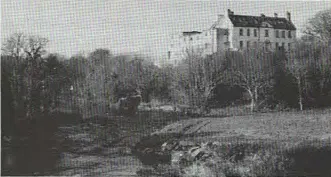
Ennistymon House has in this century been the home of the MacNamaras, used by Republican troops, become a Garda Barracks, run as a hotel and is now the Falls Hotel
COMMUNITY DEVELOPMENT
The development of the town and its resources has been the concern of some of Ennistymon's committees. Beginning with the Chamber of Commerce - made up of the commercial interests of the town - which was active in the mid '60s in working for the establishment of factories in Ennistymon, and from which later the Family Festival committee and the Tidy Town committee were spawned. In the last few years an enthusiastic Junior Chamber of Commerce has taken over many of the duties of the now less active senior group.
To the fore also has been the Credit Union committee and the Community Centre committee with their separate concerns, and a 'Liaison Group' taking on the task of coming up with employment schemes to combat the regions unemployment problems. Involved from the farming community has been the North Clare Agricultural Show committee which has continued to organise the annual one day display of livestock and horse-jumping in the grounds of the Falls Hotel.
Unfortunately Ennistymon suffers from that modern unsocial attitude known as 'apathy', as is reflected in the organisational structures. It is not surprising, therefore, to find overlap in terms of personnel within the aforementioned groups, and small groups of dedicated individuals who carry on regardless.
Sporting and cultural organisations fare better in this respect, perhaps because of a long established tradition, as is the case of the Choral Society, or as a result of the initiative taken by the 'outsiders' settling in the area as in the case of the North Clare Film Society. Below in more detail is an account of the activities of a selection of Ennistymon's cultural organisations.
ORGANISATIONS
The Choral Society: The 'Opera', as it is known, began in the 1940s in a period when Ennistymon's musical talent was so abundant as to have six bands performing or marching in the town.
The Society now confines its activities to the production of one operetta in the year, with a cast of 30 or more local acting and singing talents. The show is invariably a sell-out and runs for a week in April in the Entertainment Centre, Lahinch. The standard of the production has been enhanced in recent years by the professional producers hired to add the finishing touches.
Ennistymon and District Branch of Comhaltas Ceoltoiri: In an area so rich in traditional music and in a time when so much of it is being concentrated in pubs, the Ennistymon and District Branch of Comhaltas has provided an alternative for both young and old to learn and play.
The present branch which was established in 1981 has 40 active members (100 associate members), mostly drawn from the rural district. The branch considers the 'oiche ceili' which it runs in conjunction with Shannonside Tourism every week in Lahinch during the summer season, the highlight of its yearly activities. Up until now the branch has had no permanent venue in Ennistymon for its weekly sessions and dancing classes. In 1983 it entered into negotiations with the representative Church Body in the hope of securing the former Church of Ireland in Ennistymon as a 'teach ceol'. This request was granted in Autumn 1984.
Youth Club: Prior to the building of the Community Centre, the Youth Club held its weekly club in an extension of the old West Clare railway depot - known as the Scout Hall on the Ennis Road. The club had a membership of 100 in 1984, 90 of whom were from the town. Thanks to dedicated leadership and an excellent working committee the club is one of the strongest in Clare. It is very well represented in regional competitions and youth activities. It has won the County Clare Youth Drama competition three years in a row (1981, '82, '83) and again in 1985. The club has also been involved in youth exchanges with some North of Ireland youth clubs.
North-Clare Film Society: Set up by a group of film buffs in the mid '70s, the society attracts a membership of between 70 and 100 people from all over North Clare. Twenty general interest, non-commercial films are selected by the committee and screened weekly at the Claremont Hotel, Lahinch over the winter months. The society is a member of the Federation of Irish Film Societies.
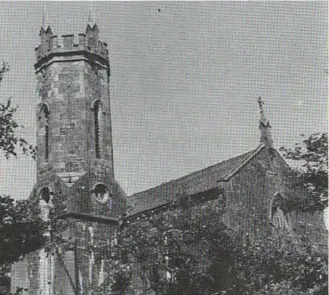
"Teach Ceol" of the Ennistymon and District Comhaltas was formerly St.Andrews Church of Ireland
VENUES
Ennistymon Library: The building of this modern library by the Co. Council in 1981 is generally considered to have marked a major departure in the social, cultural and amenity life of the town. Since then it has acquired a readership of 2,000, drawn from all of North Clare. As well as providing a much needed venue for exhibitions, lectures, etc., the building has more importantly a community atmosphere. It is a comfortable place to relax, read the paper or wait for the wife to finish the shopping!
Community Centre: In the interest of providing indoor sports facilities and community rooms, work commenced on the new Centre in 1983. The building occupies the site of the old Town Hall, for many years the Cinema, Theatre, Dance Hall, Badminton Court and Youth Club for many people in Ennistymon. The controversially large new centre contains one large multi-purpose court, a squash/handball court, and two community rooms. Already the Admirals Basketball Club, competing in the National League, has scheduled home games. The management board is active in making the Centre fully operational.
Credit Union House: The Credit Union House facing the town square had in the interim, provided a meeting place for many of the organisations, committees and clubs in the town. The Credit Union itself was founded in 1975 and had temporary offices in the Old Town Hall and later in the Courthouse. Ironically, since then the Courthouse has fallen into disrepair and the District Court now holds its sessions in the Credit Union House. Investors number about 1,200 and the Board of Directors has set up sub-offices in Kilfenora, Lisdoonvarna and Miltown Malbay.
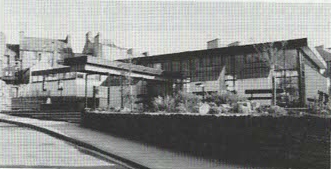
Ennistymon's Modern Co. Library
THE TOWN OF THE SHOPFRONTS
Ennistymon has in recent years become synonymous with the traditional shopfront, and famous for the resilience of its architectural character in the light of progress and modernisation. In a recent architectural study of the towns in the Mid-West (1), Ennistymon is singled out as "... a striking example of fine traditional shop-fronts, many of which are in excellent condition. It is the rich mix and variation of types which makes this the most intact example of 19th Century heritage to be found in this region, and it is therefore imperative that the maintenance and repair of each shopfront is given careful consideration".
Since the publication of the poster with the 'Pubs and Shops of Ireland' in the mid-70s which included 13 Ennistymon shops - Ennistymon people are more aware of that heritage. And in the wealth of postcards of the town printed each year, they see images - not alone of Ennistymon but also of Ireland represented by the shop-names of MacLysaght, Vaughan, Considine, Nagle, O hEagrain, and, of course, Blake and Linnane. And Ennistymon certainly benefits from the tourist trade which it all brings.
There is, however, now a genuine concern amongst some people in the town that, through neglect or disinterest, many of these fine shopfronts may be destroyed; and that the image of Ennistymon, as the 'town of the shopfronts', may eventually disappear. Furthermore, the preservation of these shops and shopfronts as practical business premises, and an attraction to the visitors, will no doubt help to focus attention on other features of the town and landscape such as the cascades, and 'glen walk' through the Falls Hotel grounds, and the atmosphere in the many fine town pubs, etc. Because, after all, it is the confluence of all these things which contribute to the life and character of the town.
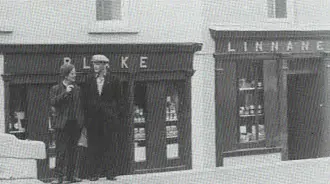
Blake and Linnane - the two most photographed shopfronts in Ennistymon
Research and text by John Doorty.
THANKS TO:
Brian G. Doyle
Brenda Ahern
Michael John Glynn
Paddy O'Dwyer
Alex Browne
Michael Concannon
Robert Bennett
Nan Ahern
Dodo Mackey
Enda Byrt
Sr. Pius
Mal Whyte
Tessie Hill
Fursa Haran
Deirdre O'Dea
Brigid Murphy
Kathleen Murphy
Next Chapter: 2. GENERAL INTRODUCTION